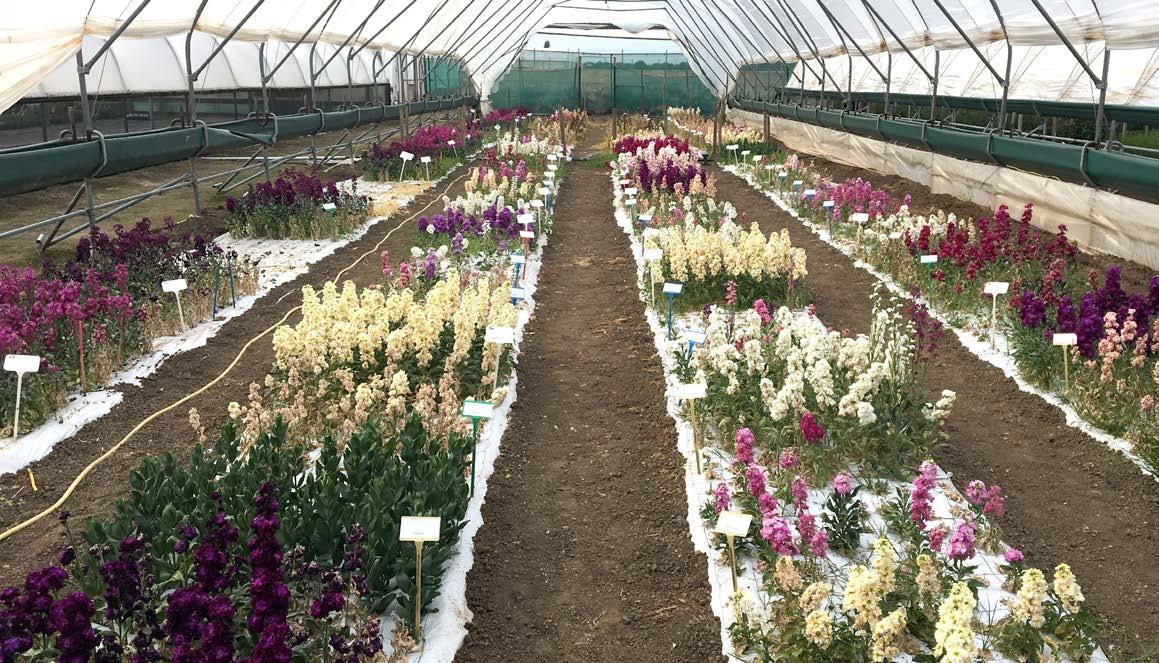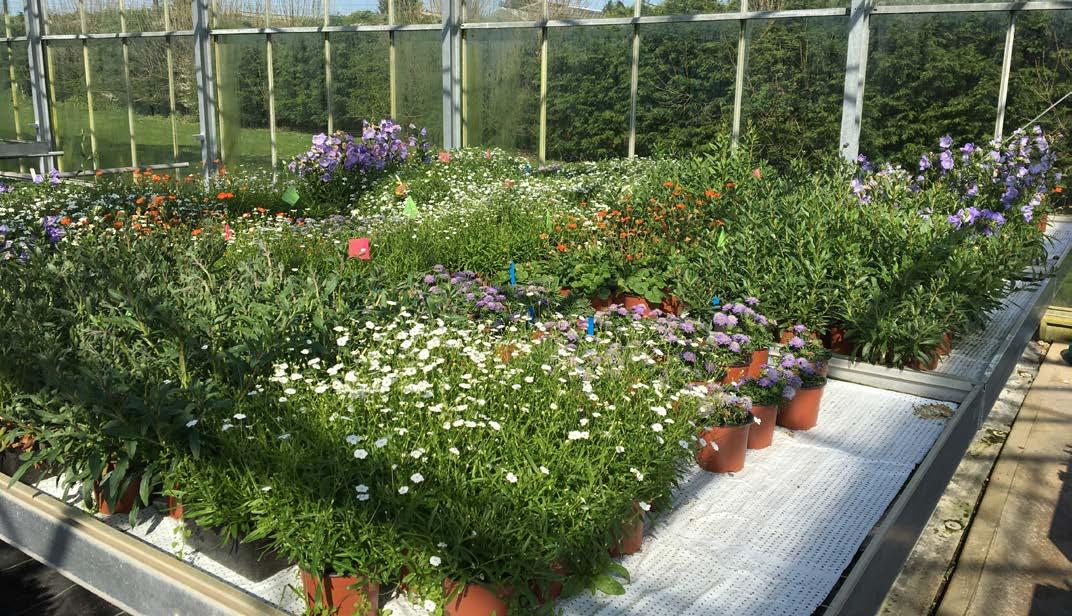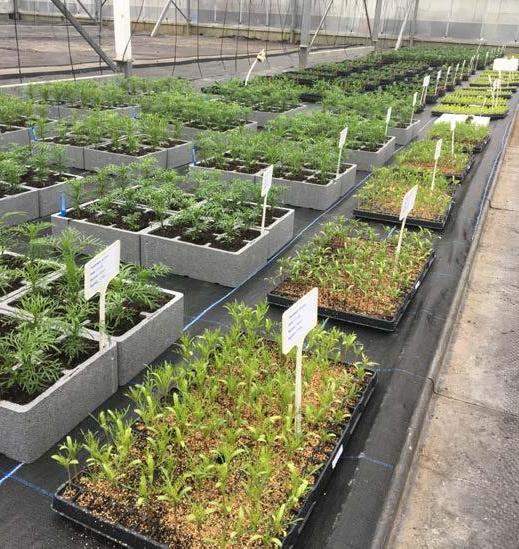
10 minute read
Breeding
Solutions for the cut flower industry
AHDB project code: PO BOF 002b The National Cut Flower Trials Centre Programme for 2018–2022 Term: January 2018 to February 2023 Project leader: Lyndon Mason, LRM Horticultural Services
Advertisement
Multiple retailers and consumers seek novelty and favour UK-grown produce, where it is available at the right price, while demanding consistent quality. Between 1988 and 2016, imports of cut flowers rose from approximately £122 million to £750 million. This increase has provided opportunities to expand production of seasonal flowers in the UK.
The project The Cut Flower Centre (CFC) was established in 2007 to deliver an industry-led programme of variety demonstrations and agronomic trials of cut flower species with market potential. Since its beginnings, it has evolved to address a wider range of issues beyond new product development, including Fusarium control in column stocks production, evaluation of new herbicide products and reactive trials examining important industry issues such as downy mildew control on column stocks.
Column stocks susceptibility to Fusarium
Results A selection of the new product development trials A variety trial examined a range of new Scabious varieties from Danziger (the ‘Scoop’ series) and HilverdaKooij. Both had an attractive range of flower colours, high yields, good vase life and potential for use by retailers.
Continuity of supply of Ammi majus and Ammi visnaga was examined. Of the two species, A. visnaga has the most potential because the stems are easier to harvest and the end product is more compact and manageable.
A number of successional plantings of Daucus carota were made from week 20 to week 32. The crop appeared as if it can be harvested at a wide range of maturities, but post-harvest work needs to be undertaken to determine the optimum stage to maximise vase life.
Trials with Veronica longifolia ‘Skyler’ series showed that both different planting dates and pinching dates were successful in extending the season of the pink- and white-flowered varieties, but for the blue-flowered variety only the planting date had any effect.
A range of new Japanese-bred column stocks varieties were compared against two traditional series for late harvest. Planted in week 29, most of the Japanese varieties did initiate a flower bud. Of the traditional series, ‘Mathilda’ initiated no flowers at all and the ‘Anytime’ series showed erratic initiation, with very few marketable stems. Unfortunately, a number of the flower spikes on

the Japanese varieties were either distorted or too short, leading to reduced marketability.
Downy mildew control on column stocks Downy mildew (Peronospora parasitica) has often been associated with column stocks but was controlled using fungicide products that contain metalaxyl-M. During spring 2018, several businesses reported downy mildew outbreaks, despite the adoption of the usual fungicide programmes.
Several fungicides were subjected to sensitivity testing using a number of downy mildew isolates gathered from different nurseries. These showed that none of the fungicides applied gave 100% control. The greatest level of control was achieved by Paraat (dimethomorph), followed by Percos (ametoctradin + dimethomorph). Very limited control was achieved by Subdue (metalaxyl-M), indicating a strong level of pathogen tolerance to this active ingredient.
Column stocks – improving control of fusarium wilt CFC trials investigated whether fusarium wilt control could be improved in column stocks. As a result, a site was artificially inoculated with F. oxysporum f. sp. mathioli. A trial was then planted using currently available commercial column stocks varieties. As a result of the high temperatures experienced during the summer of 2018, most of the plants expressed severe levels of Fusarium infection within three to four weeks of planting. Severity was such that it was not possible to see any differences in Fusarium susceptibility between the different varieties. Despite this, the trial did serve to demonstrate the species specificity of Fusarium.
Scabious variety trial
Herbicides for field-grown larkspur Nine different herbicide combinations were tested over a direct-seeded crop of field-grown larkspur sown in week 22. Although the emergence of the larkspur across the trial was variable, it was possible to identify some differences between the treatments. HDC H23 applied pre-sowing, followed by Defy (prosulfocarb) 4 L/ha postsowing, gave the highest number of germinated seedlings and also the lowest weed cover (8.3%), which suggests that this is a promising treatment.
HDC H23 applied pre-sowing, followed by Defy 3 L/ha, Dual Gold (S-metolachlor) 0.78 L/ha + Gamit 36 CS (clomazone) 0.25 L/ha or Stomp Aqua (pendimethalin) 2 L/ha + Gamit 36 CS 0.25 L/ha, also gave reasonable weed control, and crop emergence was good, which suggests that these treatments may also be suited to larkspur production.
Lily – alternatives to peat-based growing media CFC trials have tested alternative media in the past, including coir, cocopeat, wood fibre, ‘Forest Gold’, green waste, green compost and aerobic digestate. A peat-free and peat-reduced mix were compared with a peat-based medium. In terms of stem weight and length, there was no difference between any of the mixes. However, there was a large difference in terms of leaf size and colour between the peat-free and other mixes; the peat-free mix giving rise to smaller and paler leaves that made the crop unmarketable. More work is needed on the nutritional needs of the crop when using such a mix.
AHDB project code: PO 019a The Bedding and Pot Plant Centre – new product opportunities for bedding and pot plant growers Term: April 2017 to March 2019 Project leader: Jill England, ADAS
UK bedding and pot plant businesses continue to be challenged by labour shortages, an ever-decreasing number of crop protection products and a downward pressure on price with increasing input costs, all while needing to meet the retailer’s specifications and create sufficient profit to reinvest back into the business.
The project The Bedding and Pot Plant Centre was established to carry out small-scale trials to help growers of protected ornamentals exploit new product opportunities, adopt new production methods and respond to other industry issues as they arrive. The project is targeted at growers who produce finished plants on a typical small- to medium-sized bedding and pot plant nursery. Work within the project is undertaken at Baginton Nurseries in Warwickshire, which also hosts regular open days.
Results Evaluation of plant growth regulators for use on bedding plants Product revocations and label changes to key products containing chlormequat and paclobutrazol have reduced the options for growth control using chemical plant growth regulators. Two trials screened a number of other products for their potential use on bedding and pot plants. In the first, products were applied as drenches Pre-transplanting, none of the treatments examined were particularly suitable as drenches for use on Dianthus, resulting in either plugs which were too compact or phytotoxic damage. A wider range of products were suitable for use on geranium. Terpal (ethephon + mepiquat chloride) gave good growth control with no phytotoxicity, although flowering was delayed; Moddus (trinexapac-ethyl) at 0.15 L/ha showed potential, however the higher rate (0.3 L/ha) caused phytotoxicity; while Dazide Enhance (daminozide) and Pirouette (paclobutrazol) performed well. Pirouette worked well on pansy and Regalis Plus (prohexadione) showed promise on Osteospermum.
Post-transplanting, the most promising product used on Dianthus was Pirouette. However, further work is needed to determine the most effective dose rate for this species. Terpal applied as a spray was the most promising product on geranium and has potential for use at rates between 1.0–1.5 L/ha. Terpal and Pirouette applied as sprays had some potential on pansy; however, further work may be required to find the most appropriate rates. All of the new products produced too strong an effect when applied as drenches at the rates tested.
Evaluation of plant growth regulators and a new adjuvant for use on poinsettia Chlormequat-based products are widely used in poinsettia production to manage plant habit and control height. Due to product revocations and label changes, only Stabilan 750 remains and this can now only be applied twice, at a reduced rate. Alternative chemical plant growth regulators are now needed for poinsettia in the short term to manage plant development and meet specification demands.

Perennial scheduling trial

In this particular trial, the poinsettia variety ‘Vega Red’ was used, which is relatively vigorous, and as the trial was sited in a glasshouse where higher temperatures were maintained to achieve a specific customer height specification, it represented a challenge to the treatments applied.
The lower rates of Terpal examined (0.5 L/ha and 0.25 L/ha) may prove to be of greatest value to growers as they had no negative effect on bract size and shelf life (unlike the 1.0 L/ha rate) and provide the opportunity for a ‘little and often’ approach to growth control using plant growth regulators.
Bonzi (paclobutrazol) also achieved growth control and did not cause phytotoxicity. This product gave the greatest control at the highest rate examined (0.105 L/ha). The other products examined either did not control height at the rates used (to avoid phytotoxicity) or resulted in phytotoxicity.
When Stena, the adjuvant examined, was applied in combination with Stabilan 750 or Terpal, it effectively halved the dose rate required.
Forcing herbaceous perennials to extend the early spring market There is an increasing trend and interest among growers to extend the herbaceous perennial season and product range so as to provide more flowering plants during early spring, ready for impulse sales. The purpose of this trial was to identify perennials that may be produced successfully under protection with minimal energy inputs, aiming to advance the natural marketing window. some attention to scheduling to bulk up plants for early marketing; for Geum in particular it would be possible to produce good-quality plants for marketing earlier than week 14. This could include, for example, earlier seed sowing or allowing a longer period under heat prior to the cold period. Conversely, Arenaria montana was too vigorous for production under the parameters of this trial and growth would need to be reduced through a combination of adjustments to scheduling and production temperature. Campanula persicifolia ‘Takion Blue’ produced plants suitable for marketing by week 14 and 16, although plant growth regulators would be required to control growth and produce a consistent plant height.

AHDB project code:PO 023 Commercial evaluation of new poinsettia varieties Term:June 2019 to January 2020 Project leader: Harry Kitchener, HK Consultancy
Poinsettias remain a key seasonal crop for UK growers and demand continues to grow from year to year. Concern regarding the presence of pests and diseases which are classified as quarantine organisms in the UK, in crops grown in Europe, is leading to more and more retailers sourcing varieties from the UK.
Growers must produce plants which meet their customer specifications, typically 4–5 heads/bracts and a height of 26–30 cm above the pot. Over 95% of the total volume sold are red poinsettias, more so within supermarkets compared with garden centres, which tend to have a greater range of bract colours.
Each year, poinsettia breeders bring new varieties to the market, aiming for brighter-coloured, longer-lasting plants that can be grown with minimal input and without chemical growth regulators, which can be grown at higher densities and are easy to sleeve without stem breakage.
The project The aim of the variety trial was to compare, under a standard growing regime, a range of varieties from each plant breeder, which can be tracked and monitored through their growing phase and shelf life. Such trials give UK growers the opportunity to meet and discuss the new introductions which they otherwise may not be aware of and to identify varieties to grow on their own nurseries. Retailers are also interested in attending the trials to see new varieties which are better suited to UK conditions, and particularly their shelf-life performance.
Results Varieties supplied by Selecta performed the strongest in terms of their overall quality assessment, as undertaken by 29 growers at marketing in November. There was a preference for the varieties ‘Christmas Universe’ and a numbered variety. A new dark red ‘oak leaf’-type numbered variety from Beekenkamp also performed well, as did the variety ‘Ferrara’ from Dummen.
Assessments were repeated after shelf life in January. 17 growers scored the same numbered variety from Selecta as being the best-performing variety, followed closely by ‘Embla’ (from Dummen), ‘Christmas Universe’ (from Selecta) and two numbered varieties and ‘Blissful Red’ (from Beekenkamp). The standard varieties all scored equally well at the end of shelf life (‘Astro Red’, ‘Infinity Red’ and ‘Leona Red’).
There appears to be new genetics that can be grown with little or no requirement for chemical plant growth regulation and break very well to produce plants which meet market specifications, assisting growers to minimise their crop wastage.






